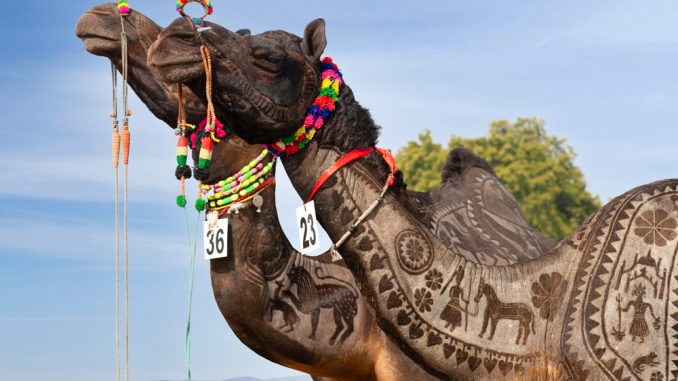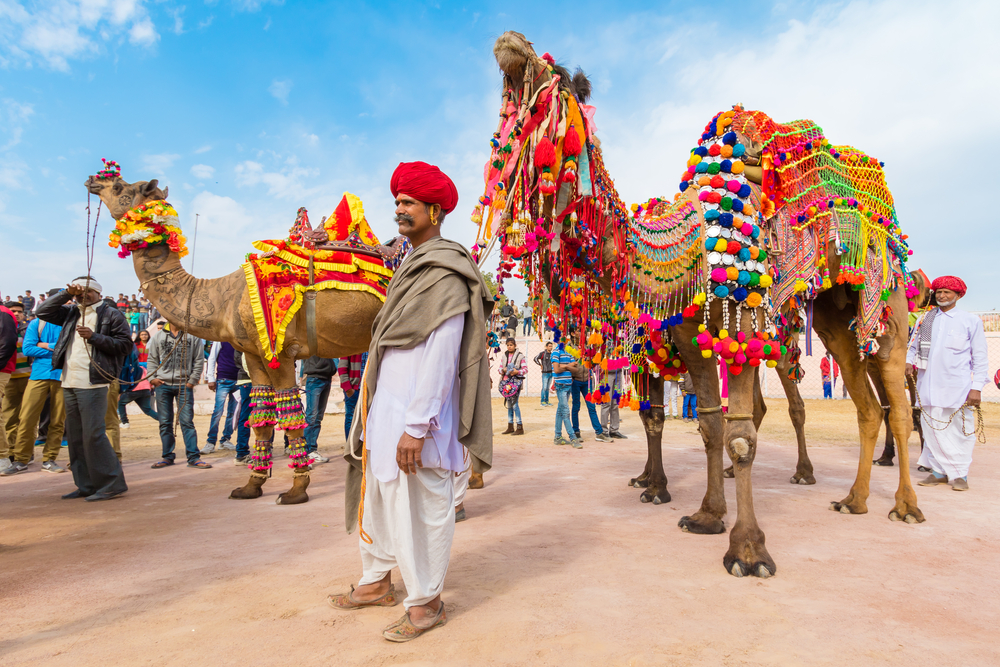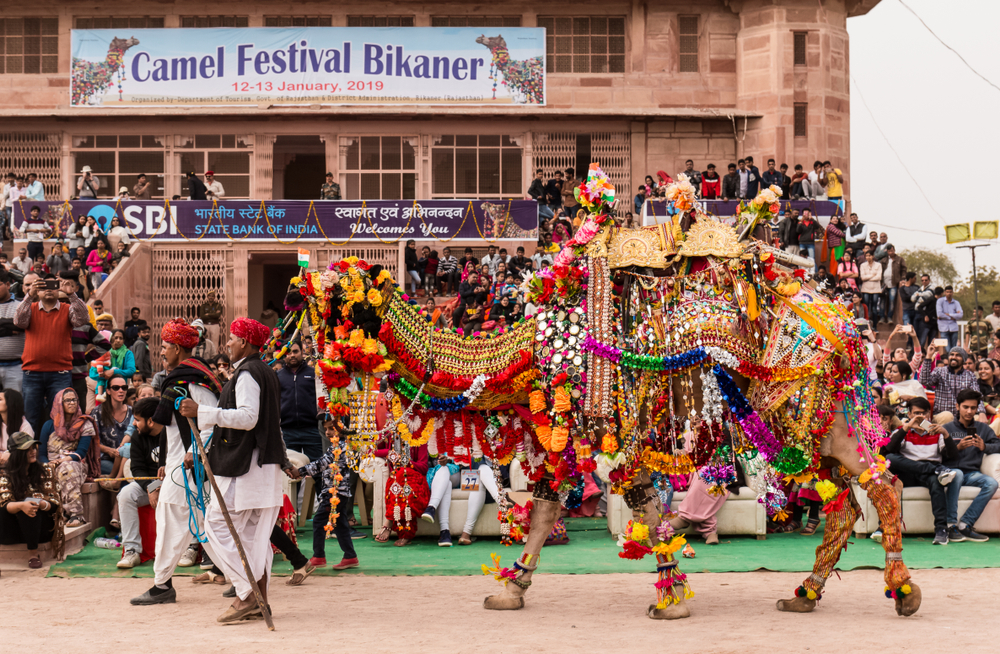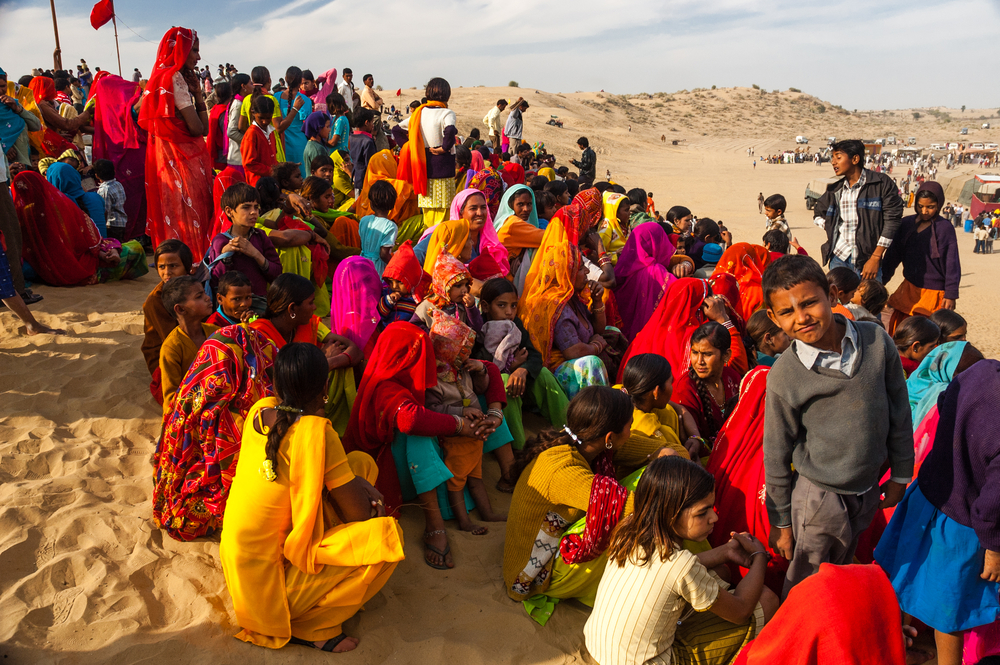
The tension builds, as the afternoon sun fades—and the main event nears. The racers are readying their animals, preparing them for the mad dash ahead. Crunching through the dunes, I approach one, my reporter’s cap on and notepad in hand, to ask him about his hopes, strategy, and plans for the winnings, should he take the top prize, which amounts to about $75.
A few seconds into the conversation, I feel something clamping down on my left arm. Overreacting, I shake it off, in the process tripping on my own feet, tumbling to the ground, flat on my back. A cluster of concerned faces looms over me, the racer and his friends embarrassed and apologizing, but it turns out I’ve only hurt my pride, nothing more.
Dusting myself off, I check my arm—no cuts or damage from the dull, ungulate teeth—and try to pat the neck of the big beast. But, ornery to the end, he’s not ready to make peace, snorting and rearing away from me.
Just another afternoon at the world’s third-largest camel festival.

‘Ships of the Desert’
A curious creature often regarded as cartoonish in the west, camels are an absolute necessity in many parts of the world. Often called the “ships of the desert,” their hardy nature—ability to go long spans without food or water—coupled with big legs and strong backs mean they can haul a lot, for long distances. And, especially in India, they are celebrated. I’m spending two days in Bikaner, in the far reaches of Rajasthan, to learn more.
When you mention camels in this part of the world, people automatically associate one place—not Bikaner, but Pushkar. Drawing some 200,000 people for the five-day event, this is the most famous camel fair in the world. Founded, like any other agricultural fair, to promote the buying and selling of livestock, new and increasingly unusual events were progressively added to the agenda, including “bridal” competitions, and a contest to see which camel has the longest mustache. A carnival atmosphere pervades, with big Ferris wheels and other midway attractions, plus picnics on the shores of Pushkar Lake.

Bikaner
While the timing didn’t work for me to visit Pushkar, I find plenty to fascinate in Bikaner. A city of about 750,000 not far from the Pakistani border, on my ride over from Jaipur, about six hours to the southeast, I see them in action. India is a country where your car window often frames several centuries of technology and history—where horses and buggies plod past shiny IT centers, and snake charmers pause to send a text on their smartphones. On the main highway, a big four-lane freeway, we pass several of the distinctive one-humped dromedaries pulling wagons stacked impossibly high with hay.
Arriving in town, I settle in for the night in the partially renovated former palace of the local maharaja—a flat-screen TV and a comfortable bed inserted into a massive room that feels like it should be roped off in a museum. Camels have a long history in Bikaner, and the city once formed a camel corps that fought in several conflicts, including both world wars. Guards on camels still patrol the border between India and Pakistan.

The Festival
The next morning, I’m on my way to a stretch of sand and dunes, where thousands are gathering for the festival. Arriving, it’s a feast for the senses. Here, smoke rises from cooking fires, carrying the fragrance of curry and saffron and other spices on the winds. There, the roar of motorbikes, young men riding up one side of the hills and rolling down the other. Families gather on blankets, sharing sweet treats. And everywhere, across the whole panorama, I see camels, these awkward creatures outfitted in costumes that span every color of the rainbow.
Adapted for arid conditions, some 80 percent of all India’s camels can be found in the deserts of Rajasthan. Originally domesticated on the Arabian Peninsula, the dromedary’s history as a beast of burden (also used in many cultures for meat and milk) dates back as much as 5,000 years. Together with two-humped Bactrian camels, they once plied trade routes across the known world. One genetic study, which sampled more than 1,000 dromedaries across 21 countries, found that their DNA was very similar, even in disparate places, a testament to the transient nature of this animal.
First, I ride—something that’s never much fun. While a photo on the back of a camel is definitely a keeper, the actual process is an awkward experience. With the animal hunched down, I swing my leg over his back, settling into the saddle. Then, as I hold onto the horn with white knuckles, with two great lurches, he rises. We follow a short circuit, each step on those tall legs huge, and deliberate. I try to imagine what it would’ve been like crossing the globe like this, and can’t. Soon, it’s time to dismount, the descent down back to the ground as herky-jerky as the trip up.
For the rest of the day, I bounce from event to event, watching an old-school wrestling competition, camel milking contents, a foot race, and pot-smashing fun. During breaks in the action, I browse handicraft stands and chat with people who have traveled hours for this event, perhaps the highlight of the year for families of camel farmers.
Beauty Contest
And then, the beauty competition. Not a lovely animal by any standard, these camels have been carefully groomed, with hair shaved and dyed into ornate patterns. Clearly, groomers have spent many hours turning these beasts into beauties. It’s a strange and wonderful sight, their necks and backs turned into checkerboards, or sculpted into flowers, hearts, distinctive archways, even the outlines of other animals, like a particularly detailed ancient cave painting, in motion.
A winner crowned, the dance follows. Before this day, I scarcely could’ve believed an animal could move like these do. Carefully trained, I hear a rumor that one expert camel choreographer from the Middle East makes a very good living planning these routines and teaching them to the animals, over weeks and months of work. With heads held high, and decorated with colorful costumes, the camels kick, rocking back and rearing toward the sky, all of it playing out to an incessant drum beat.
And finally, the main event—the race. Over on the Arabian Peninsula, prominent families have raced camels for centuries, and there, it’s big business, with robots replacing riders, prizes rising to a million dollars, and the action broadcast nationally. That’s not the case, here.
But the ragtag band of jockeys at the Bikaner Camel Festival still make these dromedaries look like thoroughbreds, hooves kicking up sand as they roar around a course that runs less than a mile. My guy doesn’t win. But that’s OK. With the sun setting, I walk toward a roaring fire—mindful of those dull teeth, and steering clear of any camel heads along the way—the night still young, the desert sky just starting to glimmer with a million stars.
Toronto-based writer Tim Johnson is always traveling, in search of the next great story. Having visited 140 countries across all seven continents, he’s tracked lions on foot in Botswana, dug for dinosaur bones in Mongolia, and walked among a half-million penguins on South Georgia Island. He contributes to some of North America’s largest publications, including CNN Travel, Bloomberg, and The Globe and Mail.






Be the first to comment